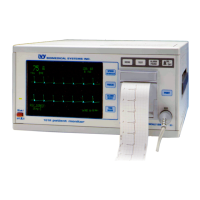THEORY OF OPERATION
Low Voltage Power Supplies
DC Voltages
The Low Voltage Power Supply is on the Mother Board. Its inputs are 13.4 V~ and 6.9 V~ from the power
transformer.
Regulators U3, U4, and U5 generate +12 V and -12 V from the 13.4 V~. D23 uses the -12 V as an input to produce
-7 V. Regulator U10 and pass transistors Q13 and Q18 generate ±8 V.
From the 6.9 V~, +8 V unregulated is taken from rectifier diodes D5 and D6. Regulator U2 generates +5 V.
Isolated DC Voltages
Isolation transformer T1 passes power from the non-isolated portion of the Mother Board to the isolated portion.
The 16 MICROSECOND SYNC signal triggers U31 which turns Q36 on and off. This creates a varying
current through the windings of T1 to allow power to be passed to transformer's secondary winding on the isolated
portion of the circuit. The rectifiers D50 through D51 generate an unregulated ±6.5 V. Regulator U39 produces ±5
V through pass transistors Q38 and Q39.
ECG Input
Isolated Amplifiers
The ECG input signals (LL, LA, RA) are applied to overvoltage protection devices and to input amplifiers U54 A,
B & C. The signals are then routed to lead selector switch U45. The selected signal is amplified by U46 and driven
by optical couplers U42 and U43, which pass the signal to the non-isolated portion of the circuit.
Lead Off Sensor
If any of the leads are disconnected, a large offset on the input signal is detected by U47, which generates the LEAD
OFF signal. This signal is passed to the non-isolated circuits through coupler U38 and sent to the digital circuits to
generate the LEAD OFF alarm. This signal, through Q46, disables the ECG amplifiers.
Shield Drive
The common-mode error signal that serves as input to the shield drive circuit is derived from the signals summed
through R242 and R243. This signal drives the shield drive amplifier U47. The output of the shield drive amplifier
returns to the patient cable serving to prevent 50/60 Hz power interference.
Lead Selection
Lead select switch U45 selects proper signals according to the levels of the L0 and L1 signals from the digital
circuitry. These signals are set according to the lead selection made by the user.
Model 101R/NR Service Manual 29

